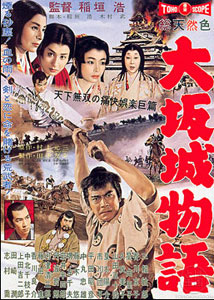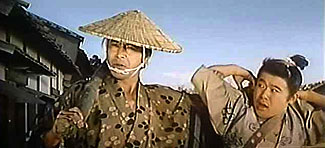 Long known in its subtitled version as Daredevil in the Castle (Osaka jo Monogatari, Toho, 1961), the Japanese title actually means Osaka Castle Story. Long known in its subtitled version as Daredevil in the Castle (Osaka jo Monogatari, Toho, 1961), the Japanese title actually means Osaka Castle Story.
For Japanese viewers any allusion to a "Tale of Osaka" instantly conjures images of the last couple years of the Warring States era & an array of tragic characters, each well known historical figures often encountered in novels, tales, comic books, movies, animated films, teledramas, live plays, even in video games. But the story of the fall of Osaka Castle is not well known to westerners, thus the English title Daredevil in the Castle was devised.
Japan stands at the cusp of Ieyasu Tokugawa's bloody ascent & the last defeat of the Toyotomi clan. Ieyasu does not have to actually appear in the story for his presence to be understood. He is looking for any excuse to besiege Osaka castle.
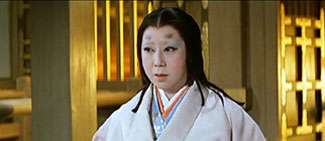 His eventual victory will herald an era of prosperity, peace, & the arts; but at such a cost to cement his dynasty of Shoguns. His eventual victory will herald an era of prosperity, peace, & the arts; but at such a cost to cement his dynasty of Shoguns.
In the castle town & village, merchants are looking forward to tripling prices as war profiteers. It angers Mohei the Demon (Toshiro Mifune) to see their misplaced pleasure. He has just arrived in Osaka, a bumpkin of a rural samurai, alone in the world after having lost all his family during Ieyasu's previous victory at the Battle of Sekigahara.
Mohei's wild & exceedingly strong. No one can stop him as he busts up one of the shops, instigating a bit of a riot, resulting in his accidentally advantageous position on a bridge where he holds back several yamabuki (monk warriors) who were concidentally chasing after Hayato Susukida (Akihiko Hirata), a Toyotomi sympathiser, & also coincidentally Mohei's closest brother-in-arms, another survivor of the Battle of Sekigahara.
The yamabuki eventually overcome Mohei & hang him from the bridge, but he's saved by the ninja Saizo (Danko Ichikawa). We're scant minutes into the film & it's been nonstop action!
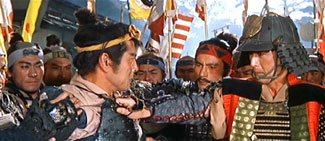 Hideyori Toyotomi (Hanshiro Iwai) prepares for war., driven forward by his mother Lady Yodo (Isuzu Yamada, a great actress who only rarely "stooped" to appearances in chambara action). Hideyori Toyotomi (Hanshiro Iwai) prepares for war., driven forward by his mother Lady Yodo (Isuzu Yamada, a great actress who only rarely "stooped" to appearances in chambara action).
Hideyori's wife is the well-famed Princess Sen (Yuriko Hoshi), wrongly mistrusted by Lady Yodo because Sen is Ieyasu's granddaughter.
There's a conspiracy to kidnap Princess Sen, whom players on both sides of the pending war care for. Well-intending spies hope she will prove to be useful in stopping the pending war, since neither Ieyasu nor Hideyori would want her to come to harm.
After Mohei the Demon was saved at the bridge, he found himself caught up, all but innocently, in this conspiracy. A girl named Ai (Kyoko Kagawa) who piloted the get-away boat under the bridge is deeply involved in these affairs. Mohei, having fallen for Ai, will do anything for her, including kidnapping. But he fails in his mission. Rival ninjas in service of Ieyasu, however, succeed at snatching her.
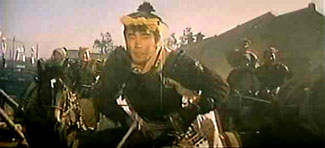 Ai & the ninja spies serve the memory of the late Lord Hideyoshi. Their failed attempt to kidnap Sen has made the situation worse rather than better. Betrayals & machinations mount up a little tediously as the center of the film loses some momentum. Ai & the ninja spies serve the memory of the late Lord Hideyoshi. Their failed attempt to kidnap Sen has made the situation worse rather than better. Betrayals & machinations mount up a little tediously as the center of the film loses some momentum.
One main thread of the story tells how Mohei the Demon saved Princess Sen from a fate worse than death. Meaning sex with a Portugese trader.
And unfortunately the bulk of the film is about on that level of nonsensicality. This is a big technicolor family film, so was never intended as a particularly serious or hard-hitting samurai yarn. It treats this ferocious historical moment a bit too frivolously, with director Hiroshi Inagaki very much inspired by the Hollywood style of historical epic.
Yet Toshiro Mifune is always worth watching & he's great fun as good-hearted, bold, brave Mohei. And many of the safe "family" oriented action scenes are fully capable of entertaining.
For one example, the blind woman Kobue (Yoshiko Kuga) who was behind the plot to stop warfare. She falls into the clutches of the evil doublecrossing merchant Itayima (Ryosuke Kagawa), but she turns out to be no mere damsel in distress. And for a director like Inagaki, who is rather too fond of faint damsels, Kobue's a thrilling side-character.
As is no surprise to anyone who knows a little of the history of the time, war is inescapable. During the final big battle, Mohei the Demon with a small contingent of Osaka laborers seeks to assist those the besieged castle. Some of their scenes are clever, witty, & heroic.
The battles themselves are rendered "large" for epic impact, but at the expense of the close-in examples of individual heroism, apart from a Mohei's band racing in the horse-drawn carts to resupply the castle, with guns & canons firing all around. It's a scene right out of a John Ford western.
It's ultimately too much a kiddy film to be really grand, yet it's a likeable "New Years" epic & Toho's biggest commercial release for 1961. Like most big commercial Toho films it includes cameos from other big stars like Tetsuro Tamba & Takashi Shimura, but don't expect to see much of them. None of it is particularly well plotted because it is a historical setting viewed from the perspective of "ordinary" people, in situations defined by figures who aren't even in the film.
Inagaki also directed a film that can be regarded as a sequel to Daredevil in the Castle. Whirlwind (Shikomado Tairyukan, 1964) picks up historically where this one ends, shortly after the fall of Osaka Castle, but with which with completely different characters, one of whom is played by Mifune.
copyright © by Paghat the Ratgirl
|
